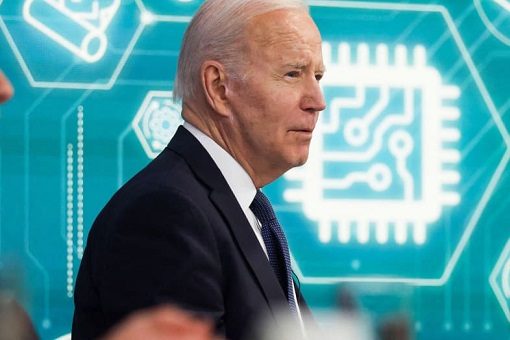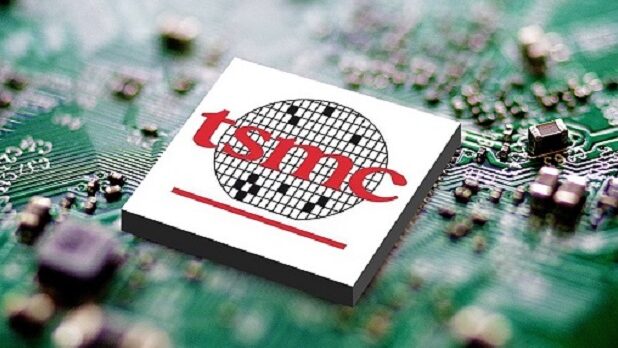BOMBSHELL – TAIWAN LOSES ITS ‘GOLDEN GOOSE’ & FOR TSMC’S SHAMEFUL FOUNDER, AN ANGRY OMEN & THUNDER CLAP FROM HIS ANCESTORS – BIDEN’S CHIP WAR GOES HAYWIRE, PLUNGING TSMC INTO FINANCIAL HELL WHILE CHINA LAUGHS ALL THE WAY TO THE BANK! – EAGER TO PLEASE U.S. & THE WEST, TSMC MAKES WORST-EVER BUSINESS DECISION & IT BOOMERANGS ‘FATALLY’ – IN NEVERENDING QUEST TO ‘KILL OFF’ CHINA, FOOLISH BIDEN NOT ONLY FLICKS ON A TICKING TIME BOMB IN TAIWAN’S ECONOMY – BUT DISRUPTS THE ENTIRE GLOBAL SUPPLY CHAIN, WITH THE CHIP INDUSTRY STUCK IN A MASSIVE GLUT OF HIS MAKING – AS FOR THE TAIWANESE PEOPLE, THEY HAVE NO ONE BETTER TO ‘THANK’ THAN ‘EVEN MORE DUMB THAN BIDEN’ TSAI ING-WEN & CO! – IT’S TIME FOR TAIWANESE TO KICK TSAI & CO OUT BEFORE THEY DO A ‘ZELENSKY’ & SELL TAIWAN TO U.S. & NATO FOR PHYSICAL DESTRUCTION ALA WAR-RAVAGED UKRAINE – AND FOR TSMC’S FOUNDER, REPENT & SEEK FORGIVENESS FROM YOUR ANCESTORS – OTHERWISE FACE THE HELLFIRE FOR BETRAYING THEM JUST TO SUCK UP TO DEVILS LIKE BIDEN & THE WEST
U.S. Chip War Goes Haywire – Taiwanese Chipmaker TSMC’s Bad Business Decision Has Boomeranged
Biden’s game to cripple the Chinese semiconductor industry was simple – prevents China from getting the world’s most advanced chips. At the same time, he signed an executive order last August to boost the U.S. competitiveness with a whopping US$52.7 billion subsidy in semiconductor manufacturing and research. The goal was to kill China without killing global chip supplies.
The law – “Chips and Science Act” – was specially designed to prevent companies from building production facilities in China and bans American companies from supplying equipment that China could use to produce advanced chips. The U.S. was actually very vulnerable – depending on Asia for 75% of its semiconductors. To hell with free trade and globalization.
Apart from reducing reliance on overseas suppliers, Biden also hopes his measures could boost high-tech manufacturing at home as well as create jobs. America was basically throwing everything, including the kitchen sink, to stop China – the US’ main competitor for economic and military influence globally – from becoming a superpower and challenge the U.S. hegemony and dominance.

The chip war, an extension of Trump’s tech war, was part of Washington’s bid for self-sufficiency in semiconductors in the long run. In reality, the U.S. was spooked by the threat that China might invade Taiwan, the world’s biggest producer of cutting-edge microchips. Therefore, US-friendly chip powerhouses South Korea, Japan and Taiwan were pressured to join an alliance called “Chip 4 Alliance”.
However, the Chip 4 alliance is a double-edged sword. While the plan to diversify the Taiwanese semiconductor giant – TSMC (Taiwan Semiconductor Manufacturing Co Ltd) – to new factories in the U.S. sounds awesome, some people in Taiwan have expressed concern that the relocation would also erode the island’s so-called Silicon Shield, which could help deter an invasion from China.
As the world’s go-to foundry for many cutting-edge semiconductors, TSMC produces microchips for big boys like Apple, Nvidia, Advanced Micro Devices (AMD), MediaTek and Qualcomm. And as the world’s largest foundry, TSMC accounted for 54% of total foundry revenue globally last year. Thanks to TSMC, Taiwan commanded more than 60% of total global foundry revenue in 2020.
It’s not hard to see how the shifting of TSMC to the U.S. will do more damage to Taiwan. Without TSMC, Taiwan will certainly lose its only leverage. China does not need to think twice about supply chain interruption before invading whilst the U.S. does not need to care about defending Taiwan. But Biden’s simple plan isn’t a walk in the park, and TSMC is paying the price now.
TSMC saw billions wiped from its valuation as shares plunged 27% last year, despite announcing the start of mass production of its 3-nanometre chips. Its latest revenue for the three months ended March 2023 fell 5% from a year earlier. Not only the company expects sales to remain sluggish this quarter, it also forecasts revenue will fall year over year for the whole of 2023.
To make matters worse, the semiconductor inventory turnover increased to 132 days from 85 days. Global smartphone shipments fell 12% the first quarter of 2023, while PC sales dropped 29% from a year earlier. But the company’s biggest problem is its investments in Arizona. Apparently, the so-called US$52.7 billion subsidy offered by Biden isn’t a free lunch.
The Taiwanese microchip company needs to share any excess profits with the U.S. government. In addition, to receive money from the CHIPS Act fund, chipmakers must agree not to expand capacity in “foreign countries of concern” such as China for 10 years and cannot engage in any joint research or licensing efforts with those countries involving sensitive technologies.
Initially, TSMC planned to spend US$12 billion to build and operate a 4-nanometer semiconductor fab in northern Phoenix, Arizona. It then announced the opening of the company’s second chip plant in Arizona, raising the total investments to US$40 billion. Yet, till today, TSMC, seeking to get US$15 billion subsidies, is still negotiating with the U.S. over how to receive the money.
At the same time, the company was facing problem hiring American workers. Not only the cost of producing chips in the U.S. is about 40% higher than that in Taiwan, university graduates in the U.S. prefer to work with Intel than TSMC. Worse, not many Americans wanted to enter the chip-manufacturing sector – the exact problem highlighted by Apple CEO Tim Cook.
Even if workers could be recruited, there’s a huge culture clash between American and Taiwanese employees. In Taiwan, engineers work long hours and weekend shifts. Such sacrifices are non-existent in the U.S. Hence, it creates a new problem – training – where Taiwanese engineers refuse to be relocated to the U.S. after learning they would have to pick up the slack for U.S. recruits.
Wayne Chiu, an engineer who left TSMC last year revealed the ugly truth – “The most difficult thing about wafer manufacturing is not technology. The most difficult thing is personnel management. Americans are the worst because they are the most difficult to manage.” Unlike Taiwanese, who obediently do as told, American employees would challenge managers.
![]()
To lure Taiwan-based TSMC engineers to move to Arizona, the company has to offer double salaries and higher benefits, which in turn will increase the prices of of consumer electronics devices. Most Americans also reject being given multiple tasks or assignments, let alone work harder like Asians – one of the reasons Tim Cook refuses to close down Apple factories in China and shifts back home.
As the biggest maker of chips that power everything from smartphones to cars and from home appliances to missiles, TSMC has also revealed that the U.S. plants could be at least four times the cost in Taiwan, largely caused by labor expenses, permits, regulatory compliance and inflation – factors that could hurt the company’s profitability for a very long time.
Unlike Taiwan, TSMC suppliers in the U.S. were too far away to provide the Arizona plant with raw materials, equipment and critical parts. Suppliers trying to join in were hit with labour shortages and high costs. For example, Chang Chun Arizona, a chemical supplier that invested US$300 million in Casa Grande, found that the construction cost of its factory was 10 times the cost in Taiwan.
With so many known problems, why did TSMC go ahead with the overseas expansion? The company had no choice due to geopolitical pressure. It came under tremendous pressure from both the Taiwanese government as well as Biden administration. Actually, it knew it was a bad business decision as its first American investment happened more than two decades ago.
In the late 1990s, TSMC founder Morris Chang tried to create a chip-making subsidiary, WaferTech, in Washington State. The project failed miserably due to the same problem – high costs and a shortage of skilled labour. As recent as 2021, he told the audience at a public forum that the success of TSMC in Taiwan could not be “replicated” in the United States.
Kirk Yang, chairman of the private equity firm Kirkland Capital and a former tech analyst, said – “TSMC’s investment in the U.S. from a business perspective makes no sense at all.” He agreed that the company was forced to set up a factory in the U.S. because of political reason. And TSMC would end up spending billions on plants that could not produce enough chips to make it worth the investment.
It will definitely be a disaster if TSMC cannot produce enough in the U.S. and at the same time cannot operate in China. It reminds us again of what former U.S. Secretary of State Henry Kissinger once said – “It may be dangerous to be America’s enemy, but to be America’s friend is fatal.” Burning a big hole in the pocket is one thing. Losing the lucrative Chinese market is another thing altogether.
The Chip War will not be able to destroy the Chinese semiconductor industry. China’s largest chip manufacturer, Semiconductor Manufacturing International Corporation (SMIC), recorded revenue of US$7.2 billion last year – up 34% from the previous year. Biden’s grand plan to contain China’s technological rise has instead disrupted the global supply chain to the extent of creating a glut in the market.
The glut saw a slowdown in semiconductor sales. The oversupply in the semiconductor also means a drop in prices. The fact that SMIC was doing a roaring business suggests that the Chinese chip self-sufficiency has jumped tremendously. Last year, Beijing splashed US$1.75 billion in subsidies for 190 companies and pumped US$7.26 billion into upgrading chip supply chain.
FINANCE TWITTER
.
